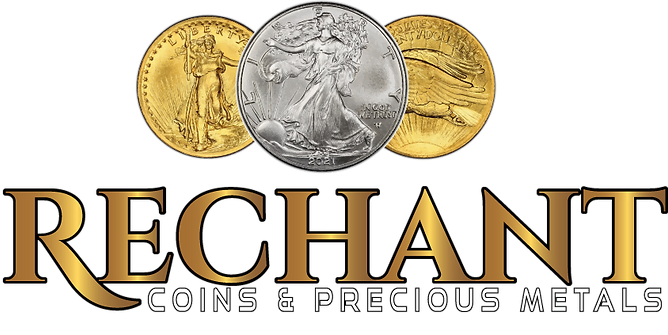Gold Bullion Investment Strategy Tips
Invest in gold bullion to safeguard your wealth with a time-tested strategy that balances security and potential growth. Whether you're exploring the flexibility of fractional coins, the stability of gold bars, or the historical allure of rare coins, there’s much to uncover.
As experts, we at Rechant Coins & Precious Metals, serving South Florida since 1975, are here to guide you.
Learn practical tips on building a robust portfolio (finance), understanding the true value of gold, and why consulting trusted professionals matters.
Let us show you how to make gold work for your long-term financial goals.
Click here to learn more about: for sale now
Gold Bullion Investment Strategy Tips
Gold as an investment requires a well-thought-out strategy for success. Begin by researching every detail about gold bullion, whether it's coins, bars, or rounds.
For example, American Gold Eagles, renowned for their liquidity and global recognition, are a preferred choice for many investors. On the other hand, fractional gold bars and coins can diversify your portfolio while being an affordable starting point.
When you buy gold, partnering with a local dealer is essential.
At Rechant Coins & Precious Metals, based in West Palm Beach, we offer free appraisals and the most competitive rates, ensuring your investment reflects the true value of gold.
Whether you choose a rare gold coin like a St. Gaudens Double Eagle or a modern bullion piece such as the South African Krugerrand, having expert guidance can minimize financial risk and enhance returns. Next, let’s explore why gold's value serves as a solid foundation for wealth preservation.
The Value of Gold: A Timeless Asset
Gold’s significance extends beyond its investment appeal; it has represented wealth and stability for millennia.
For civilizations like the Romans, gold served as currency, a status symbol, and a reliable asset during times of turmoil. Gold as a way to preserve wealth has endured, maintaining its relevance in modern economies.
Physical gold offers a unique hedge against inflation and currency devaluation, insulating portfolios from market volatility.
Gold’s Role in Wealth Protection
Investors buy gold during economic uncertainty because of its tangible value.
Owning gold coins and bars not only diversifies holdings but also provides a secure hedge in uncertain markets.
At Rechant Coins & Precious Metals, we often assist collectors and investors in identifying historically significant gold coins like the American Gold Buffalo, which combines beauty with financial security.
Preserving Value Across Generations
An ounce of gold retains its purchasing power through financial upheavals, making it a cornerstone asset in any portfolio. Unlike fiat money, gold offers intrinsic value that does not rely on government backing.
This is why many turn to gold investment strategies during inflationary periods. Whether investing in gold bullion, collectible coins, or modern minted bars, ensuring that your gold holds value over time is essential for long-term wealth preservation.
Discovering Unique Ways to Invest in Gold and the Power of Diversification
Gold as an investment offers unparalleled avenues for both experienced collectors and those eager to diversify their portfolios. This article uncovers alternative ways to invest in gold, diving into rare coins and collectible bullion options that go beyond traditional methods.
We'll outline how gold diversification stabilizes portfolios and reduces financial risk during uncertain economic conditions.
Whether you're a seasoned investor or just starting, you'll find practical insights to bolster your wealth-building strategy.
Exploring Different Ways to Invest
Investing in gold doesn’t always mean acquiring large gold bars.
For a more individualized approach to gold investment, rare coins and collectible bullion provide an excellent starting point. Many gold investors seek out items like the historic St. Gaudens Double Eagles, which carry both numismatic and intrinsic value. These coins are not only a tangible store of wealth but also a beautiful representation of historical craftsmanship.
Modern collectible bullion presents another opportunity for those considering this way to invest in gold.
The Chinese Gold Panda and American Gold Eagles, for example, blend aesthetic appeal with substantial investment potential.
Fractional coins, such as 1/10 oz Gold Eagles, cater to new investors or those with limited capital, without compromising on the integrity of the precious metal.
Such options allow you to diversify effectively with physical assets that retain long-term value.
Additionally, gold bullion isn’t limited to just coins; collectible ingots and smaller bars are practical for investors who prefer more flexibility.
These assets provide an excellent opportunity to gain exposure to the price of gold while accommodating your portfolio size and investment goals.
By exploring these different methods, you’re taking proactive steps to add resilience to your financial portfolio.
Benefits of Diversifying With Gold
Adding gold to your portfolio introduces a layer of stability often unavailable through traditional investments. Historically, when stocks and bonds experience downturns, gold prices tend to rise.
This inverse correlation makes gold an ideal hedge against volatility, particularly during periods of economic uncertainty.
Reducing Financial Risk
Gold investment strategies are powerfully effective in managing financial risk.
Unlike fiat currencies that lose value over time due to inflation, physical gold retains its intrinsic worth.
Investing in tangible assets like gold bars or coins ensures that your wealth is protected even when traditional markets face unpredictable shifts. This is why an increasing number of investors buy gold not only as a store of value but also as insurance against economic instability.
Achieving Portfolio Resilience
Incorporating gold bullion or rare coins into your investment strategy offers unparalleled advantages for those seeking balance in their portfolios.
Gold reduces portfolio correlation, providing a much-needed buffer against the impact of stock market volatility. This added layer of protection enables investors to weather financial storms while maintaining a clear path toward wealth preservation.
Whether through rare gold coins, collectible bullion, or fractional options, diversifying with gold yields lasting benefits.
By reallocating a portion of your capital to gold investments, you ensure that your portfolio is fortified to endure the ebbs and flows of the broader economy.
| Gold Investment Options | Benefits of Diversification |
|---|---|
| Rare coins like St. Gaudens Double Eagles | Stability during economic uncertainty |
| Modern collectible bullion such as Gold Pandas | Hedge against stock market volatility |
| Fractional coins like 1/10 oz Gold Eagles | Protection against inflation |
Unveiling the Secrets of Investing in Gold: Trends, Strategies, and Expert Insights
Have you ever wondered what makes gold such a unique asset, or why investors flock to it in times of uncertainty? This section explores the fascinating factors influencing gold prices and how you can effectively balance risk and volatility in your gold investment strategy. Whether you're a seasoned investor or just getting started, these insights could help refine your approach to buying physical gold, diversifying your portfolio, and navigating fluctuating markets.
Factors Influencing Gold Prices
Gold has consistently emerged as a sought-after precious metal, revered for its status as both a luxury commodity and a strategic investment tool.
Multiple elements shape gold prices, often creating a ripple effect across the broader market.
These influences are not random but tied to tangible global and economic dynamics.
Market Demand and Cultural Trends
Gold's allure is partly driven by its dual demand across industries.
On one hand, it is central to high-value jewelry production, especially during cultural celebrations or wedding seasons worldwide. On the other, gold serves as a safe haven for those seeking to protect their assets during economic uncertainty.
This dual function positions gold uniquely, causing frequent price shifts. For instance, increased demand during festive seasons in India or China often correlates with temporary spikes in gold bullion valuations.
Geopolitical and Economic Tensions
Unrest across geopolitical landscapes amplifies tension in financial markets, prompting many to invest in gold as a hedge against unpredictable consequences.
When global events such as wars, trade disputes, or political turmoil occur, the appeal of gold as a stable asset grows significantly.
For example, during major global conflicts, gold prices have surged as investors move capital toward this perceived crisis commodity.
Inflation and Currency Fluctuations
As an effective hedge against inflation, gold stands out particularly when the purchasing power of fiat currencies declines.
Its intrinsic value remains steady even during dramatic shifts in the global economy. Historically, gold prices rise when inflation is high, protecting long-term wealth.
Fluctuations in the United States dollar—a key benchmark for international trade—can directly and inversely impact the purchasing power of gold for foreign buyers.
Balancing Risk and Volatility in Gold
Managing risk while ensuring a solid return on your gold investment requires a blend of strategic actions and informed choices. Buying gold might feel like a straightforward decision, but understanding how to reduce exposure to volatility will make all the difference between short-term losses and long-term gains.
Dollar-cost averaging for Consistency
One of the most effective strategies for minimizing financial risk is adopting a dollar-cost averaging method.
Instead of timing the market, this approach spreads your investments over regular intervals, buying a fixed amount of physical gold regardless of its price.
This has been shown to reduce the impact of market fluctuations while steadily building your portfolio.
It's a particularly useful technique if you're hesitant about market timing due to gold’s volatility.
“Dollar-cost averaging smooths out price fluctuations by consistently investing a set amount over time, regardless of market highs or lows. ”
Diversifying Across Gold Formats
Diversification isn't just about mixing different assets—it can be applied within your gold holdings as well. Combining investments in gold coins, bars, and even rare bullion ensures that your portfolio minimizes potential risks from falling demand in one specific format.
For South Florida residents, local trusted dealers like Rechant Coins & Precious Metals offer access to diverse gold products, enhancing your options for portfolio diversification.
“By diversifying into gold coins, bars, and bullion, investors create a more resilient portfolio capable of withstanding market shocks. ”
Whether choosing to invest in physical gold or balancing between different precious metals, working with a knowledgeable dealer can dramatically impact the outcome of your investment. At Rechant, we assist clients in exploring personalized strategies suited to their specific goals.
Local Expertise: A Strategic Advantage
Gold investors from Palm Beach to Fort Lauderdale know that having access to expert guidance adds a unique layer of security to their financial decisions.
With decades of experience in the industry, Rechant Coins offers a no-pressure environment where you can freely explore your options and refine your investment goals.
From rare gold bars to collectible coins, our inventory ensures a comprehensive variety for any type of buyer or seller.
“Partnering with seasoned professionals ensures clarity, fair pricing, and confidence every step of the way. ”
Key Insights on Gold Investment
- Gold prices are influenced by global economic dynamics, including inflation and currency fluctuations.
- Geopolitical tensions and economic uncertainty drive increased demand for gold as a stable asset.
- Diversifying across gold formats, such as coins, bars, and bullion, helps minimize investment risks.
- Adopting dollar-cost averaging reduces the impact of market volatility and builds a consistent portfolio.
The Ultimate Guide to Gold Investments: Physical Gold vs. ETFs and Inflation Hedge Strategies
Gold remains a cornerstone of wealth preservation and a go-to asset for investors.
Whether you're considering owning physical gold like bullion or exploring the high liquidity of gold ETFs, understanding their differences is key.
This section explores the reliability of gold as a hedge against inflation, explaining when it works best and where it might underperform.
Let’s explore these topics in detail to help you make informed investment decisions and safeguard your portfolio.
Comparing Physical Gold and ETFs
When you invest in gold, understanding the differences between physical gold and exchange-traded funds (ETFs) is essential for aligning your investment goals. Physical gold, such as gold coins and bullion bars, offers the unique benefit of direct ownership.
It is a way to buy gold that ensures you possess a tangible asset often viewed as a safeguard against economic uncertainty and devaluing currency.
Owning physical gold requires storage solutions, which may include vaults, safety deposit boxes, or insurance to protect against theft. These added costs can affect the overall investment.
The liquidity of physical gold is typically lower, meaning it might take time to sell at the desired price.
Gold ETFs, on the other hand, provide exposure to gold through financial markets without requiring physical possession.
They are known for their high market liquidity and ease of trading.
This makes ETFs a popular choice for short-term trading strategies, allowing investors to quickly buy or sell to capitalize on gold price fluctuations. Gold ETFs lack the intrinsic value and security associated with owning physical gold, exposing holders to market risks and potential volatility.
If your primary goal is long-term wealth preservation, physical gold might offer more reliability despite its storage requirements.
For those focused on short-term diversification within a broader portfolio, gold ETFs provide flexibility without the need to manage a tangible investment.
Gold as a Hedge Against Inflation
Many investors turn to gold as a way to protect their wealth against inflation. A primary reason is that gold often maintains its purchasing power during periods of rising inflation or currency devaluation.
For example, in the 1970s—an era marked by high inflation—gold prices surged dramatically, cementing its reputation as a reliable hedge.
Owning physical gold during such times could safeguard your assets when paper currencies lose significant value.
However, investing in gold depends on economic conditions.
During periods of economic stability and low inflation, the price of gold may remain flat or even decline. This is because gold does not generate interest or dividends, unlike other investment options such as bonds or mutual funds.
Therefore, it is important to evaluate your investment decisions alongside broader economic trends before buying gold as a hedge.
To make the most of gold's potential as an inflation hedge, consider integrating it into a diversified portfolio. This approach balances the inherent risks while leveraging gold's ability to act as financial insurance.
Monitoring indicators like the Consumer Price Index (CPI) can also guide your timing for purchasing physical gold or other gold-based options.
While no single investment is foolproof, including some amount of gold in your strategy can provide stability, especially in times of economic uncertainty.
Investors across the United States have historically relied on gold for its intrinsic value, tangible nature, and role as a store of wealth that spans centuries.
Key Insights on Gold Investments
- Physical gold provides tangible ownership and acts as a safeguard against economic uncertainty.
- Gold ETFs offer high market liquidity and are ideal for short-term trading strategies.
- Gold often maintains purchasing power during inflation but may underperform in stable economic conditions.
- Diversifying a portfolio with gold can provide stability during times of economic uncertainty.
Expert Guidance for Gold Investments: What You Need to Know
Gold as an investment offers a timeless appeal, but making informed decisions requires experience and knowledge about the precious metal market. Whether you're new to investing or an experienced gold investor, seeking professional advice is key to protecting your wealth.
In this section, we’ll explore how to find credible advisors, what certifications to look for, and the role of transparency in gold and precious metal investments.
From understanding certifications to evaluating customer feedback, these steps ensure your portfolio grows with confidence.
Verifying Credibility: Key Steps to Finding the Right Financial Adviser
If you’re ready to buy gold or expand your portfolio with gold bullion, choosing the right financial adviser can significantly impact your success.
Experienced advisers understand the complexities of the gold price, market trends, and how gold fits within a diversified portfolio. Here's how to verify their credentials:
- Confirm Industry Certifications
- Look for advisors certified by reputable organizations such as the Professional Coin Grading Service (PCGS) or Numismatic Guarantee Company (NGC). These validate expertise in evaluating gold coins, gold bars, and other investment-grade assets.
- Seeking advisors affiliated with institutions like the American Numismatic Association (ANA) or Florida United Numismatics (FUN) ensures they adhere to high ethical and professional standards.
Evaluate Practical Experience
- Advisers with extensive experience in gold mining stocks or gold bullion strategies bring valuable insights.
- Ask about specific cases where they helped investors diversify in gold and silver, achieve financial growth, or hedge against inflation and market volatility.
“A certified and experienced financial adviser doesn’t just provide advice—they offer peace of mind when you invest in gold. ”
Transparency: The Foundation of Trustworthy Financial Advice
Whether you plan to purchase gold bars, invest in physical gold, or diversify into gold coins, an adviser’s transparency is critical. Here’s what to consider:
Open Communication on Pricing and Fees
- Advisors should clearly explain their pricing model, including any fees tied to the purchase, storage, or sale of gold assets. Avoid individuals who withhold this information.
- A transparent adviser will provide detailed insights into the current gold price, how it’s influenced by global demand, and the potential for growth.
Customer Reviews and Testimonials
- Check reviews that highlight the adviser’s ability to deliver on promises, particularly for gold investment strategies and navigating financial risk.
- Positive feedback often points to successful outcomes, such as securing stable gold bullion during economic uncertainty.
“Trustworthy advisers prioritize transparency, helping investors navigate the complexities of buying and selling gold. ”
When seeking expert advice on gold investments, remember that certifications, experience, and transparency are non-negotiable. By following these steps, you can confidently pursue opportunities in the gold market, safeguard your capital, and enjoy the enduring value of your investment.
Gold Investments
- Certified advisors from organizations like PCGS and NGC ensure expertise in gold assets.
- Experienced advisers can help mitigate financial risks like inflation and market volatility.
- Transparency in pricing and fees is crucial for building trust with financial advisers.
- Positive customer reviews highlight advisers' success in navigating economic uncertainty.










